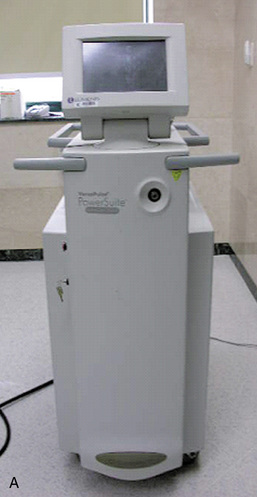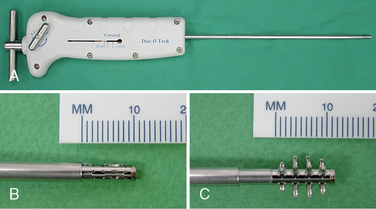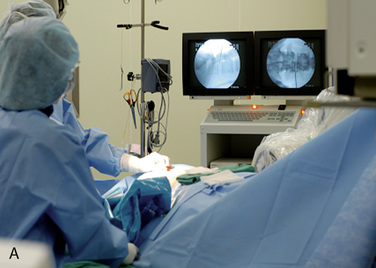Chapter 23 Percutaneous Endoscopic Cervical Discectomy and Stabilization
Percutaneous endoscopic cervical discectomy (PECD) is a relatively new surgical method for treating soft cervical disc herniations [1–7]. The goal of the procedure is decompression of the spinal nerve root by percutaneous removal of the herniated mass under local anesthesia. A holmium:yttrium-aluminum-garnet (Ho:YAG) laser is generally used to ablate and shrink the herniated disc [1–7].
The WSH cervical endoscopy set (Karl Storz, Tuttlingen, Germany) consists of a high-resolution endoscope, illumination, and two irrigation channels [7]. The working channel allows passage of a side-firing Ho:YAG laser and microforceps. The excellent visualization via the endoscope permits the surgeon to selectively remove a portion of the herniated nucleus pulposus. After the anular anchorage has been loosened by the side-firing laser, the herniated fragment can be removed easily with the microforceps. With circumferential rotation of the working cannula and the endoscope, the side-firing laser can also ablate the thickened ligamentum flavum, remnant bone fragment, and shoulder osteophyte.
The major advantages of PECD and PECD stabilization (PECDS) with the B-Twin spacer are as follows [8–12]:
 Minimal insult to anterior anulus, anterior longitudinal ligament, longus colli muscle, and anterior vertebral body
Minimal insult to anterior anulus, anterior longitudinal ligament, longus colli muscle, and anterior vertebral bodyIndications and contraindications
The indication for PECD or PECDS (Box 23.1) is a soft cervical disc herniation that shows no response to conservative treatment for 6 weeks.
Preoperative preparation
The primary patient complaint is cervical radiculopathy or neck pain.
Imaging diagnosis consists of the following modalities and findings:
Instrumentation
Equipment
The following instruments and modalities are required in the operating room for PECD/PECDS:

Figure 23–1 A set of percutaneous endoscopic cervical discectomy (PECD) instruments. (Karl Storz, Germany)
Anesthesia and Other Medications
 To decrease the risk of infection, preoperative antibiotics (usually 1.0 g of cefazolin) should be given the day before operation. Preoperative sedatives are recommended.
To decrease the risk of infection, preoperative antibiotics (usually 1.0 g of cefazolin) should be given the day before operation. Preoperative sedatives are recommended.
































